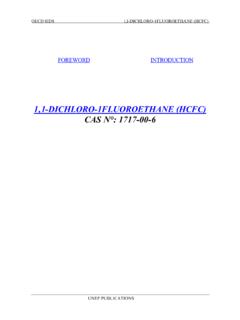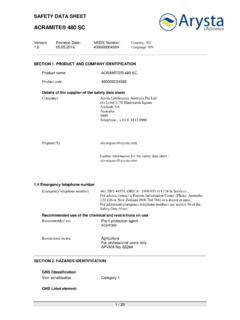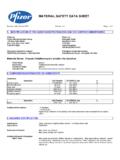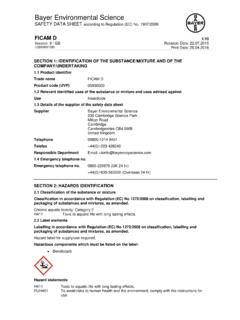Transcription of Guidance Document on the Assessment of ... - …
1 1 Guidance Document on the Assessment of Chemicals for Endocrine Disruption Version 9 ( with changes to V8 accepted, 17 November 2010) Table of contents Page A. Introduction 3 Objectives 3 General approach 4 Scope and limitations 5 B. General Guidance 13 Considerations on the tests addressed 14 Endpoints in the various assays of the Conceptual Framework 22 C. Specific Guidance for the Test Guidelines addressed 38 Introduction to specific Guidance 38 In vitro screens 39 ER Binding Assay (US EPA OPPTS ) 39 AR Binding Assay (US EPA OPPTS ) 56 OECD TG 455: The Stably Transfected Human ER Transcriptional Activation Assay for Detection of Estrogenic Agonist-Activity of Chemicals (ER STTA) (including Guidance for the antagonism assay) 73 H295R Steroidogenesis Assay (draft OECD TG) (US EPA OPPTS ) 89 Aromatase Assay (US EPA OPPTS ) 104 Wildlife screens and tests 121 OECD TG 229: Fish Short Term Reproduction Assay (FSTRA) 121 OECD TG 230: 21 Day Fish Assay 140 Variant of OECD TG 230: Androgenised Female Stickleback Screen (AFSS) 152 Fish Sexual Development Test (FSDT) 167 Fish Lifecycle Toxicity Test (FLCTT) 192 OECD TG 231.
2 Amphibian Metamorphosis Assay (AMA) 203 OECD TG 206: Avian Reproduction Test 219 Mammalian screens and tests 230 2 Table of contents Page OECD TG 440: Uterotrophic Bioassay in Rodents (UT) (including OECD Guidance Document on the use of the assay to screen for anti-estrogenicity) 230 OECD TG 441: Hershberger Bioassay in Rats (H Assay) (including Guidance Document for Weanling Hershberger Bioassay) 244 Pubertal Development and Thyroid Function Assay in Peripubertal Male Rats (Male PP Assay) (US EPA OPPTS ) 260 Pubertal Development and Thyroid Function Assay in Peripubertal Female Rats (Female PP Assay) (US EPA OPPTS ) 278 OECD TG 407: Repeated Dose 28 Day Oral Toxicity Study in Rodents 295 OECD TG 416: Two-Generation Reproduction Toxicity Study (including TG 415: One-Generation Reproduction Toxicity Study) 311 Annex 1. The OECD Conceptual Framework for Testing and Assessment of Endocrine Disrupting Chemicals with revisions.
3 334 Annex 2. Provisional Guidance on assays not included in the main Document 338 Annex In vitro screens: 349 Annex The Human AR Transcriptional Activation Assay for Detection of Androgen (Ant)agonist-Activity of Chemicals (AR STTA) 349 Annex Wildlife screens and tests: 364 Annex Fish (Medaka) Multi-Generation Test (MMGT) 364 Annex Amphibian Development, Growth and Reproduction Assay (ADGRA) 381 Annex Avian Two Generation Test (ATGT) 394 Annex Mammalian screens and tests: 412 Annex Adult Male Assay 412 Annex TG 408: Repeated Dose 90 Day Oral Toxicity Study in Rodents 428 Annex OECD TG 453: Combined Chronic Toxicity/Carcinogenicity Studies (including TG 452 Chronic Toxicity Studies) 438 Annex OECD TG 421 Reproduction/Developmental Toxicity Screening Test and TG 422 Combined Repeated Dose Toxicity Study with the Reproduction/Developmental Toxicity Screening Test 448 Annex Extended One-Generation Reproductive Toxicity Study 462 Annex 3.
4 Information on endocrine assay costs 483 Annex 4. Glossary and definitions 488 Annex 5. References 492 3 A. Introduction The OECD initiated a high-priority activity in 1998 to revise existing and to develop new Test Guidelines for the screening and testing of endocrine disrupting chemicals. Since then a number of potential assays have been developed into Test Guidelines and others are in development. The screens and tests are contained within the OECD Conceptual Framework for the Screening and Testing of Endocrine Disrupting Chemicals (CF) (Annex 1). A workshop on OECD Countries Activities Regarding Testing, Assessment and Management of Endocrine Disruptors was held in Copenhagen on 22-24 September 2009 (OECD, 2010b). One output from this workshop was a recommendation that a Guidance Document on the Assessment of chemicals for endocrine disruption should be developed by the EDTA Advisory Group (AG).
5 This was supported by the EDTA AG at its meeting on 17-18 May 2010. The objectives and scope of the Guidance Document were defined such that the Document would be a tool to support regulatory authorities without prejudging or constraining what regulatory actions may be taken by a member country and without suggesting a testing strategy. The Guidance should also support but not duplicate other Guidance documents Guidance on hazard Assessment . It should be noted that the use of many of these tests for determination of endocrine toxicity (hazard and risk Assessment ) for mammals and wildlife is rather new, and therefore the Guidance given is considered to be subject to changes based on new evidence. The Guidance is intended to be a living Document that will be updated as the science in this area evolves.
6 In the context of this Document , an endocrine disrupter (ED) and a potential ED have been defined according to WHO (2003), An ED is an exogenous substance or mixture that alters function(s) of the endocrine system and consequently causes adverse health effects in an intact organism, or its progeny, or (sub) populations. A potential ED is an exogenous substance or mixture that possesses properties that might be expected to lead to endocrine disruption in an intact organism, or its progeny, or (sub) populations. It is acknowledged that many other definitions exist (eg Weybridge Conference, 1996) but the WHO (2003) definition has been used as a working definition for this Document because it covers both human health and wildlife populations. This definition is widely used but not universally accepted. Objectives The objectives of the Guidance Document are: 4 To support regulatory authorities decisions on the hazard of specific chemicals when they receive test results from a Test Guideline (TG) or draft TG for the screening/testing of chemicals for endocrine disrupting properties.
7 The contexts for these decisions will vary, depending on local legislation and practice, so the advice is worded in such a way as to permit flexible interpretation. To provide Guidance on how to interpret the outcome of individual tests and how to increase evidence on whether or not a substance may be an ED. Testing strategies or Guidance on interpretation from a suite of tests are not given. To minimise animal testing globally through application of the 3Rs (Replace, Reduce and Refine the use of laboratory animals in testing) in a two step process: o Use of a harmonised framework for assessing test results together with existing information should avoid unnecessary animal testing. o Recommendation of a test method that may be performed if regulatory authorities need more evidence. The test method is defined precisely to facilitate the Mutual Acceptance of Data and.
8 Avoid unnecessary duplication of testing. The recommended test method will utilise non-animal tests where possible although a few alternative scenarios are considered depending upon existing information. General Approach The general approach taken by this Guidance Document is primarily to consider the possible results that might be obtained from each endocrine disruption-responsive assay, and to provide Guidance about how these results might be interpreted in the light of data that may or may not already be available from other in vitro or in vivo assays. The nature, quantity and quality of the existing and new data in each of these scenarios should be evaluated in a weight-of-evidence approach, and there is generally no single right answer. This Guidance Document should therefore be used flexibly in the light of local regulatory needs.
9 The key questions addressed concern likely mechanisms of endocrine action and any resulting apical effects that can be attributed to such action. Given the widely agreed definition of endocrine disrupting chemicals (WHO, 2003), the advice only suggests that a chemical is an ED if an adverse in vivo effect can be plausibly linked to an endocrine mode of action. Secondly, this Document provides advice on the next step in testing (if any) which might be appropriate for a regulatory authority to take, given the various data scenarios. Advice on further testing which may be needed to assist in deciding if a chemical is an ED is generally limited to a single next step, and this Guidance Document therefore does not present an entire hazard testing strategy for possible EDs. 5 The key advice for each assay is given in the form of a table which lists a series of scenarios for combinations of different assay results and varying backgrounds of existing data, and provides advice on interpretation and further testing which may be considered in each scenario.
10 However, each table should be read in conjunction with preceding text that explains issues related to the assay and for which there is insufficient space in the tabular format. Once again, it is important to note that these tables (so-called building blocks ) are purely advisory, so individual regulatory authorities are not in any way bound to follow the advice. This is all the more important given that the guidelines for testing for endocrine disruption are relatively new and the field will probably develop further. Scope and Limitations The scope of the main section of the Guidance Document is limited to providing Guidance on how to interpret results from assays included in the revised OECD Conceptual Framework (CF) for testing and Assessment of EDs (see Annex 1). Guidance is provided on the endpoints for these assays with respect to the endocrine modalities listed below, followed by Guidance on how to increase evidence that a chemical is/is not an ED based on the result from the Test Guideline under consideration and other existing relevant information.

















